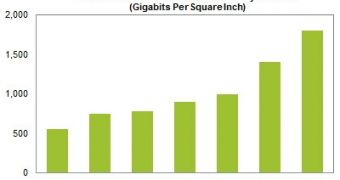We've been writing about hard disk drives and how the so-called crisis wasn't really that big a crisis at all, and now we are taking up the subject again, although not in the same manner.
Rather than pulling apart from the seams the whole not-crisis matter, we'll report on what analysts think the future holds for this segment.
IHS iSuppli has conducted a study recently, aiming to see what the most likely growth curve for hard disks is.
Long story short, iSuppli believes that areal density will double over the next five years (by 2016).
“The rise in areal density will pave the way for continued growth of the HDD industry. Densities will double during the next five years, despite technical difficulties associated with the perpendicular magnetic recording (PMR) technology now used to create higher-areal-density hard disks,” said Fang Zhang, analyst for storage systems at IHS.
“In particular, growth opportunities will lie in applications associated with mass enterprise storage requirements, gaming, and in digital video recorders (DVRs) where massive capacity is required to store high-definition video.”
This year, areal density is poised to rise from 2011's 744 Gb per square inch per platter to 780Gb per square inch. 2013 should see the number grow to 900. That way, in 2016, the 1,800 mark will be attained.
Currently, HDD makers use PMR technology in HDD manufacture, but its areal density limit is 1 Tb/ per square inch.
One new technique, revealed by Seagate back in March, is called HAMR (heat-assisted magnetic recording) and already promises 60 TB HDDs. The only hurdle yet to have been passed is cost: HAMR isn't exactly cheap to implement compared to PMR, and we're already dealing with, arguably unjustifiable, high HDDs prices.
Nevertheless, there doesn't seem to be much choice. PMR will not last more than two or three generations before reaching its limit. Seagate will just have to make HAMR cheaper to use until then.

 14 DAY TRIAL //
14 DAY TRIAL //